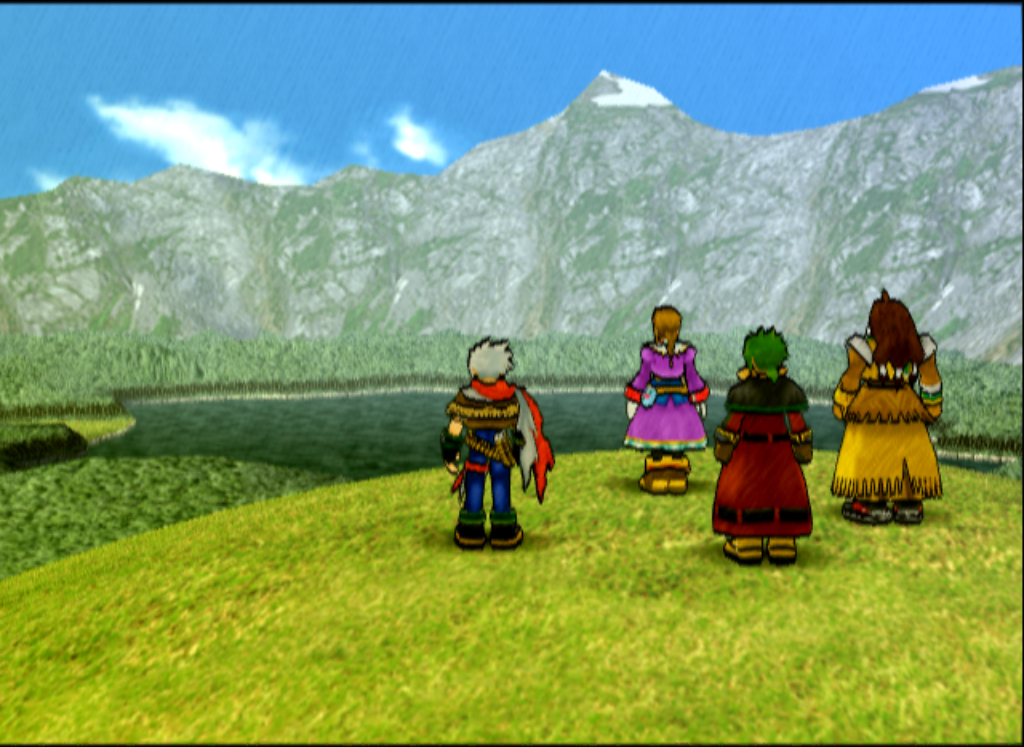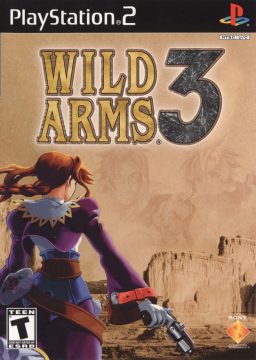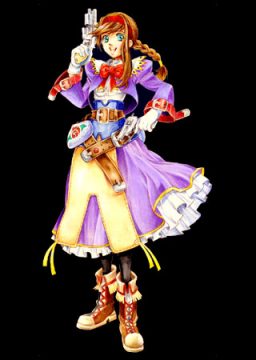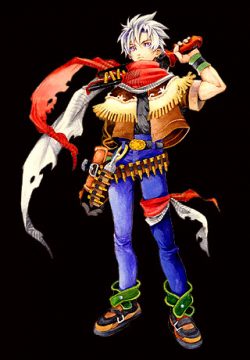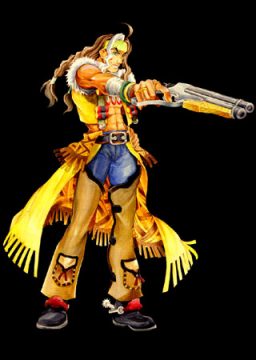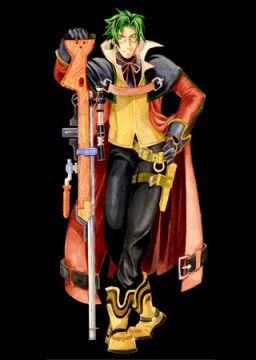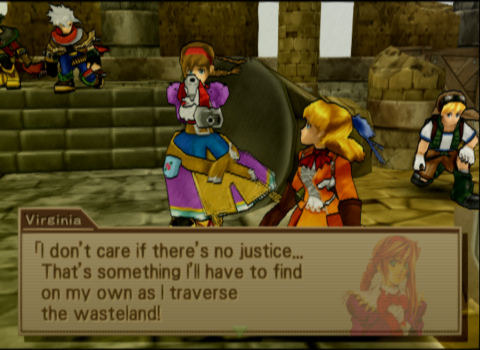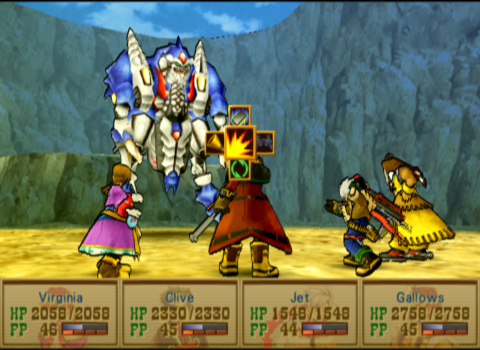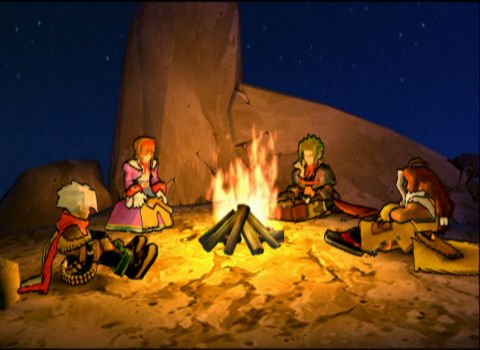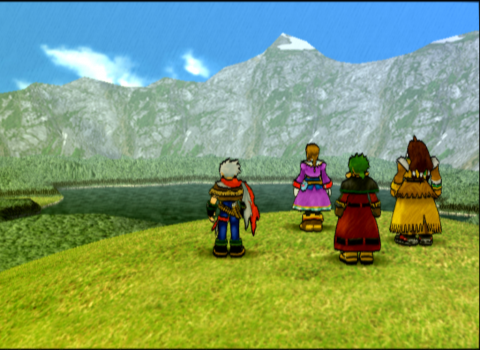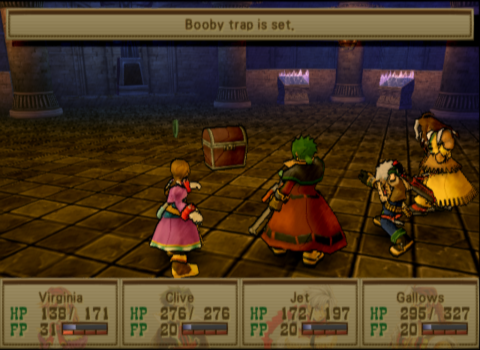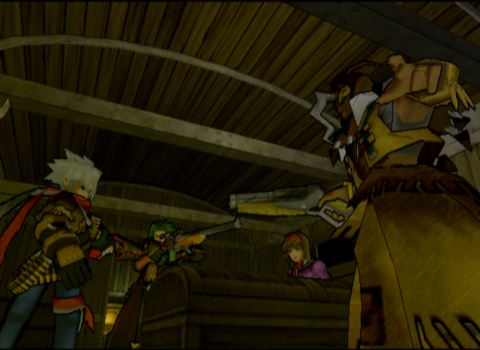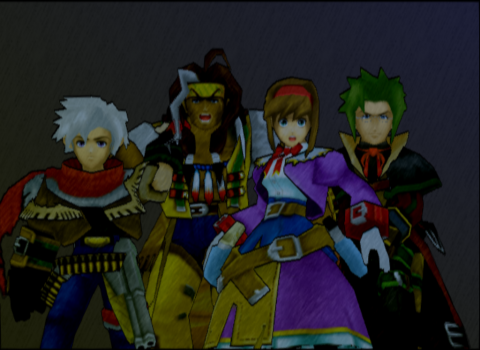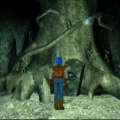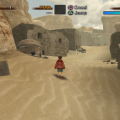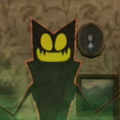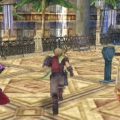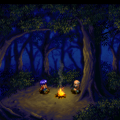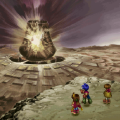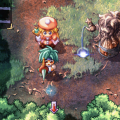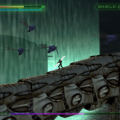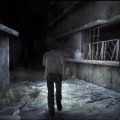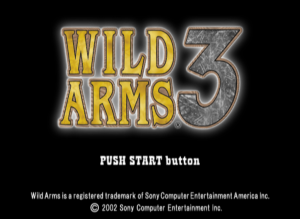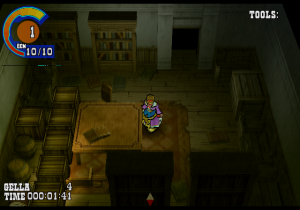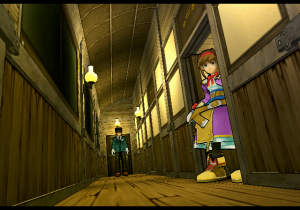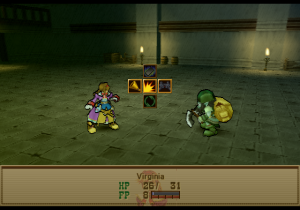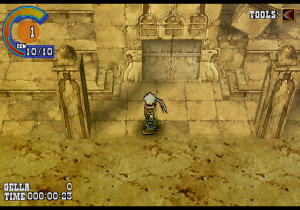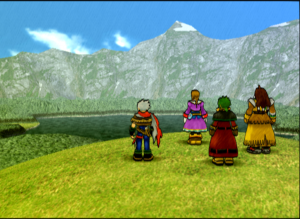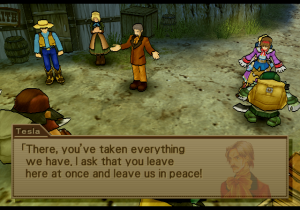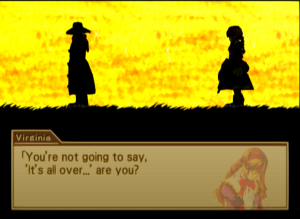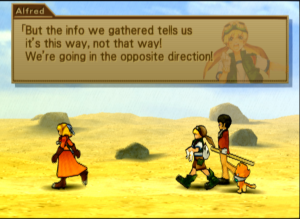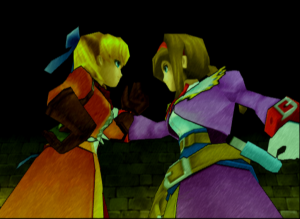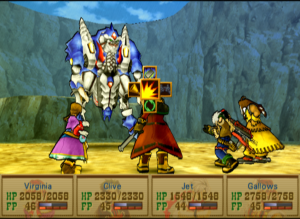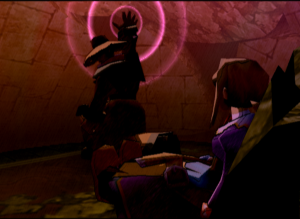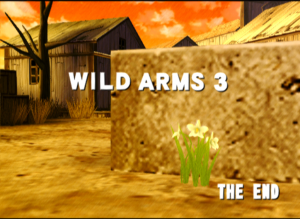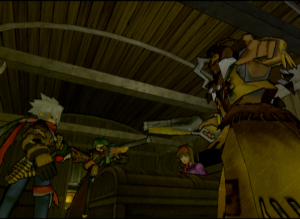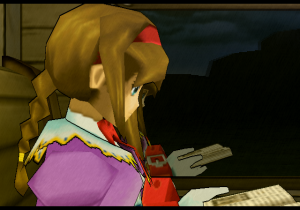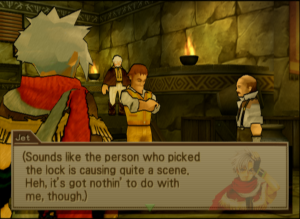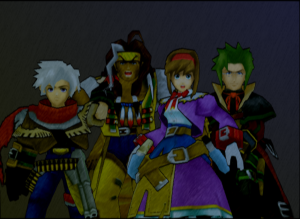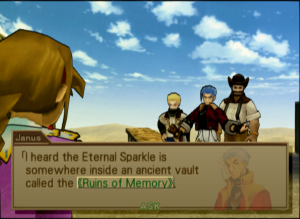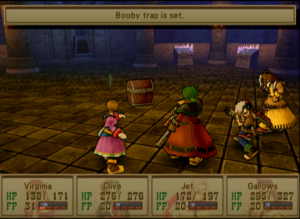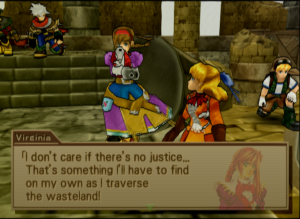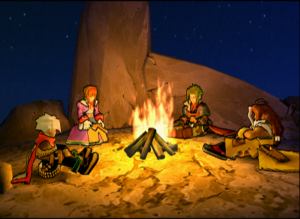Wild Arms 3 is a culmination of all the quintessentially “Wild Arms”-y elements introduced through the first two games. It is the most representative and arguably the best what the series has to offer: The gameplay is at its most intuitively complex, the puzzles are challenging but rewarding, the story is compelling (and again subtle in how much absurdity and depth it contains), the music gives those pitch perfect faux-Spaghetti Western vibes, the characters are charming and distinct. It isn’t as refined as it might be, but it is still a superior game to the first two, and, excluding the first game’s remake Alter Code F, a great send-off for the series status quo before it gets seriously revamped in the fourth game. If you were to pick one Wild Arms game to play to get a feel for the series, this is without a doubt the most recommended.
While the narrative throws as much ridiculousness at you as the second game, the pace is much better, the stakes are much more clear, and the translation is more competent. Filgaia is again on the brink of disaster, in even worse condition than previous games. The medieval and steampunk settings are less prominent now, relegated to just a couple dungeons. The entire ocean is gone, replaced by a vast sea of sand. Our heroes are four drifters (the same as Dream Chasers from the original, a general term for people who wander Filgaia as a calling) who meet one night in a freight boxcar during a foiled train robbery. The ragtag group of cowpolks then get wrapped up in a story about ecological restoration, cultural memory, artificial intelligence, and some deeply disturbing body horror.
Characters
Virginia Maxwell
A young girl and our primary point-of-view character who decides to travel the world in search of her missing father.
Jet Enduro
An arrogant silver-haired pretty boy with no memory who is motivated entirely by money.
Gallows Carradine
A dumb, lecherous Baskar man who is running away from his tribal responsibilities.
Clive Winslett
A kindhearted family man who works as a bounty hunter.
Right off, the characters and their dynamics are tremendously endearing. Virginia is an excellent lead, written with surprising progressiveness. Her unwavering optimism and naivety seem more apt in a JRPG as characteristics for a lesser role, a cringe-y comic relief or contrast to the stoic hero (Rinoa of Final Fantasy VIII comes to mind), but the group selects her as their leader and accepts her outlook without much problem at all. Her fixation on her father risks leading into the problem of the recent Tomb Raider games, that being how the female protagonist is defined entirely by her relationship to a man, but that isn’t the case here. She holds her own in the group, and doesn’t even have to suffer through a hackneyed romance subplot.
The other characters are also quite lively: Though Jet is the most stereotypical, he works as a great foil for the rest of the group, causing the most tension between the four protagonists. Gallows is a fun, if somewhat questionable, subversion of Magical Native American tropes, with his slothful nature and hotheadedness. Clive is sweet and softspoken, and he graciously manages throughout the story to be happily married and a loving father without either of those relations dying.
Villains and side characters are strong this time around too. The mainstay enemies-turned-allies are the Schrodinger Gang, a quirky ensemble of four characters: Maya, their lead, a treasure hunter who bears remarkable similarity to Calamity Jane from the first game; Alfred, her demolitions expert little brother; Shady, a talking cat; and Todd, Maya’s bodyguard/butler/right-hand man who is a master of Quick Draw. These characters stand in delightfully amoral opposition to the more pure mission of Virginia’s team—rather than wanting to save the world, they are motivated instead by hubris and monetary gain.
Meanwhile, the villains get gradually more twisted and powerful as the game goes on. You start with Janus, an insignificant bandit who becomes a demon. Watching his humanity gradually drain away and his cruelty grow is similar to Bosch from Breath of Fire: Dragon Quarter, and equally as sad and strange. The Prophets, three mysterious cloaked individuals who seem bent on destroying the world in order to rebirth it, are okay as the main villains for the majority of the game, but they especially shine when a surprise blast from the past returns to lead them. WA3 also continues the tradition of switching up the villains partway through the story, and here it’s even more surprising and out of left field than ever before. That said, there are actually many clever clues leading up to the villain reveal—the character shows up in the background of various cutscenes and in inaccessible locations in towns. Additionally, there are mentions of this villain in some of the journals relatively early on in the game. It’s an effective fridge-horror tactic, realizing that there’s been something much darker and more sinister than what you’ve been fighting lurking in the background this whole time.
The battle system has been revamped. It’s still turn-based, but there are a few key changes. Cosmetically, characters now run around the map rather than stand in a line, giving it a more cinematic edge. This is especially fun when you’re riding a horse on the world map, as battles will take place on horseback. It’s purely visual, there are no “area” spells or range-dependent attacks, but it is effective in giving the battles a greater sense of urgency. Plus, the visual appeal of battles does wonders for making random encounters less tedious. I mean, they’re still tedious because they’re random battles, but it could be much worse.
Most significantly for the actual mechanics of battle, however, is the fact that all the characters now wield ARMs as their primary weapons. Each carries their unique ARM: Virginia has two pistols, Clive has a rifle, Gallows has a shotgun, and Jet has a machine gun. Each ARM also has its own backstory tied to the character (aside from Gallows, whose ARM is never brought up). They upgrade just like in previous games, although this time around the upgrade cap is set at 15. Like in all other games they need to be reloaded, but now instead of using an item you reload by spending a turn defending. Otherwise you’re given the choice to melee the enemy, which is much weaker than shooting.
Everyone also uses magic now. Crest grids are gone, replaced by equipping guardian mediums. Each guardian has a set of four spells and each character has three spaces for equipping mediums, so there are twelve mediums total and space for twelve spells on each character. You can switch mediums in battle at any point, which is good because really only Gallows is actually any good at using attack spells, and you’ll occasionally find yourself with an enemy who can only be damaged with certain elements. As with WA2, MP doesn’t exist and magic requires you to have a certain amount of FP instead, which doesn’t go down after usage. Guardians can be summoned at any time as well, with the caveat that there is a limit on how many times you can use them until you need to rest at an inn. Guardian summon strength is determined by how much FP you have.
In general magic is a bit more clever this time around, with stat-focused spells being a lot more creative and important than previous games. One of the most essential to making the game easier, for example, is Valiant, which increases your attack power based on the difference between your current HP and max HP. Take enough damage and you can give incredible amounts of damage in return. This is especially great for Gallows, whose weak defense and high HP means the discrepancy will be high.
There are also some trick bosses, like one who is immune to damage until the end of each round, after each character has already made their move. It seems broken and impossible to beat until you remember there’s a skill named Replay that allows a character to perform their turn action again at the end of each round. Cast it on Clive, the main tank, then have him attack, and the boss suddenly becomes extremely easy to defeat. Bosses are, for the most part, only difficult because of quirks like this, which can be annoying, but they vary the gameplay up a bit and keep it from getting too easy even if you’re overleveled.
Equipment is gone, no weapons or armor or anything to buy, replaced by a new approach to personal skills. Where personal skills were a fixed list that everyone had in common in WA2, now everyone’s personal skills are determined by mediums. Every medium has a set of built-in skills and can equip five accessories that contain further personal skills. So for the most part, characters will have different skills that they need to mix and match according to battle necessity. The catch is, the accessory is deleted permanently if you remove them. This isn’t a big deal for easy-to-find items like elemental rings, but it can be very dangerous for some of the more essential and powerful accessories, most notably the game-breakingly powerful Violator. You assign a level-aligned amount of points to each personal skill (i.e. a level 30 character will have 30 skill points), which grow in power each time you upgrade them. For example, you’ll be only somewhat immune to fire if you only upgrade the Fire Ring twice, but upgrade the max four times and you’ll be completely immune.
A lot of Wild Arms 3‘s gameplay complexity is brought by the fact that its nitty gritty dynamics are never actually explained in-game. Gaining bonus experience is the biggest hidden element to exploit. Oftentimes, bosses won’t actually drop enough experience for you to keep up with the difficulty curve. You can use Lucky Cards to double your experience, but these are finite. To get even more bonuses you have to tinker with personal skills. For instance, if you’re wearing a fully powered Fire Ring, you get an additional 0.1x experience every time an enemy attacks that character with fire. These bonuses can stack quickly, and exploiting them makes this one of the few JRPGs where it isn’t actually especially difficult to max out your level. Late game optional bosses have so much HP that getting to 9.9x EXP isn’t difficult at all.
Regrettably, navigation is Wild Arms 3 is even worse than in the second game. The world is larger and uses a more uniform palette, location clues are vague, and reaching locations can be complicated. Oftentimes you will get clues that add up to a mere cardinal direction from your current location. So, let’s say, you are told there’s a location west of Baskar Colony. You search and search but can’t find anything west of Baskar Colony. Turns out, the place you’re looking for is on an entirely different continent to the west of Baskar Colony. The game just didn’t mention that part. Miscommunications and ambiguities like that can lead to hours of tedious searching on the world map. At least in Wild Arms 2, many NPCs would often change their dialogue to help point you in the right direction, and if you forgot where you were supposed to be headed you could use the communicator to remind you. Again, you can get an item that reveals where items and locations on the map are, but it takes a long time to reach the point when that sidequest is available, and if you haven’t used a guide you’ll probably already have been searching for places for far too long.
Battles can again be canceled with the O button, but WA3 introduces Migrant Seals, Booster Kits, and the ENC (“ENCounter”) gauge. You start out with 10 ENC points, and each time you cancel a battle, depending on how strong the enemies are, that 10 ENC will decrease by a certain amount. More Migrant Seals means less ENC taken away, to the point where weaker enemies will give green exclamation points that don’t decrease your ENC when canceled at all. Booster Kits raise your ENC count, for a total of 50. ENC can be recovered by resting at inns, fighting battles, or finding white crystals in dungeons. For the most part it’s a good system, the only thing WA2‘s more simplified system having over it is that the previous game rewarded you for being overleveled. Here you are instead rewarded for gathering Migrant Seals, which are rare and easy to miss. Since the encounter rate is pretty high, getting behind on Migrant Seals can make the game drag.
The graphics are, for the most part, beautiful and stylish, another testament to the fact that good aesthetics will carry a game’s visual memorability far more than a powerful graphics engine. Cel-shading is the key here, with vibrant colors overlaying a brown, decaying landscape. Unfortunately dungeons tend to look a little too similar and the world map is bland (you will get very tired of yellow-tan colors, and all the dungeons have the same pyramid-shaped icon), but the character models are great and as the game goes on the places you visit gradually get weirder, eventually transmogrifying into some bizarre H.R. Giger-like sights.
Sidequests in Wild Arms 3 are numerous but not terribly fun. A few are actually pretty necessary: Gunner’s Heaven, the Colosseum-esque sidequest, is helpful for obtaining scopes that make navigation easier. The Secret Garden sidequest is crucial for getting a decent amount of healing items, as they are even more scarce this time around. There are however three extremely long ones: The Millennium Puzzles, twenty different moving block puzzles strewn about the map that each provide small prizes; Telepath Towers, an alien-invasion themed series of boss battles, also strewn about the world map, and one of the only missable sidequests; and the Abyss, the infamous 100-level dungeon with no save points that leads to Raga O Ragula. With the puzzles and the towers you at least don’t have to complete them entirely to get a satisfying amount of rewards, but they still take a lot of time. Otherwise there is a series of optional bosses found within various dungeons, mostly good as a means of getting more experience and useful personal skills. They don’t feel quite as arbitrary as in WA2, which is good, and there are only a handful of them. One nice easter egg is the ability to fight Lolithia from the first game—there are quite a few nods to the original, in fact, especially in place and enemy names (Ka Dingel is one of the first dungeons, where in the first game it was one of the last). The main goal of finishing these quests is to get EX File Keys, which can be used to gain certain post-game rewards. Obtaining two is really all you need, however, as that’s all that’s required to access New Game +.
Again, it isn’t a perfect game, but it is definitely the most refined of the first three. Aside from the remake of the original, which follows Wild Arms 3‘s format relatively closely, the series from here breaks off into another direction, emphasizing platforming, anime trappings, and a new hexagon-based battle system. Perhaps another sequel in the same vein as the first three would have proved to be an even more polished version of the form, but this game is still a pretty fantastic peak to reach.
